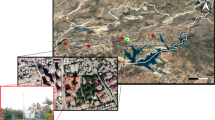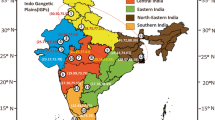Abstract
In this study, we investigate the influence of vegetation variations on dust activity (dust load, dust transport in the troposphere, and dust weather frequency) over Northeast Asia during springtime. By using the Integrated Wind Erosion Modeling System, two model experiments are run over four-month periods, from February 1 to May 31, for each year from 1982 to 2006; one experiment uses the observed atmospheric conditions and vegetation (OBS), and the other uses the specified atmospheric conditions in 2006 and the observed vegetation (CTRL). Comparison of the two model experiments reveals that there are sensitive regions in southeastern Mongolia and central northern China, in which vegetation has a large potential to influence dust activity due to both the high dust emission rate and large variations in vegetation coverage. Over these sensitive regions, vegetation effectively lessens dust loads on interannual and interdecadal timescales; dust load is decreased by 2864 μg m−2 for an increment of 0.1 in the normalized difference vegetation index (NDVI). Vegetation increase in the sensitive areas also reduces two major branches of dust transports in the low troposphere; one stretches from eastern Mongolia to regions northeastward, and the other flows across the south of northeastern China to Korea. In addition to dust loads and transports, vegetation increase in the sensitive areas evidently decreases dust storm frequency and blowing dust frequency, but it exerts a weak influence on the floating dust frequency. In the sensitive regions, as NDVI increases by 0.1, dust storms, blowing dust, and floating dust decrease by 4.0 days/spring, 1.5 days/spring, and 0.2 days/spring, respectively. In summary, vegetation variations in southeastern Mongolia and central northern China have considerable impact on northeast Asian dust during springtime.
Similar content being viewed by others
References
Carlson, T. N. and D. A. Ripley, 1997: On the relation between ndvi, fractional vegetation cover, and leaf area index. Remote Sens. Environ., 62, 241–252.
Chadwick, O. A., L. A. Derry, P. M. Vitousek, B. J. Huebert, and L. O. Hedin, 1999: Changing sources of nutrients during four million years of ecosystem development. Nature, 397, 491–497.
Engelstaedter, S., K. E. Kohfeld, I. Tegen, and S. P. Harrison, 2003: Controls of dust emissions by vegetation and topographic depressions: An evaluation using dust storm frequency data. Geophys. Res. Lett., 30, 1294, doi:10.1029/2002GL016471.
Ganguly, S., M. A. Schull, A. Samanta, N. V. Shabanov, C. Milesi, R. R. Nemani, Y. Knyazikhin, and R. B. Myneni, 2008: Generating vegetation leaf area index earth system data record from multiple sensors. Part 1: Theory. Remote Sens. Environ., 112, 4333–4343.
Gong, S. L., X. Y. Zhang, T. L. Zhao, and L. A. Barrie, 2003: Sensitivity of Asian dust storm to natural and anthropogenic factors. Geophys. Res. Lett., 31, L07210, doi:10.1029/2004GL019502.
____, _____, _____, X. B. Zhang, L. A. Barrie, I. G. McKendry, and C. S. Zhao, 2006: A simulated climatology of Asian dust aerosol and its trans-Pacific transport. Part II: Interannual variability and climate connections. J. Climate, 19, 104–122.
Gutman, G., and A. Ignatov, 1998: The derivation of the green vegetation fraction from NOAA/AVHRR data for use in numerical weather prediction models. Int. J. Remote Sens., 19, 1533–1543.
Lee, E. H., and B. J. Sohn, 2009: Examining the impact of wind and surface vegetation on the Asian dust occurrence over three classified source regions. J. Geophys. Res., 114, D06205, doi:10.1029/2008JD010687.
Mao, R., C. H. Ho, Y. Shao, D. Y. Gong, and J. Kim, 2011a: Influence of arctic oscillation on dust activity over Northeast Asia in the Integrated wind erosion modeling system. Atmos. Environ., 45, 326–337.
____, D. Y. Gong, J. D. Bao, and Y. D. Fan, 2011b: Possible influence of arctic oscillation on dust storm frequency in North China. J. of Geographical Sciences, 21, 207–218.
Natsagdorj, L., D. Jugder, and Y. S. Chung, 2003: Analysis of dust storms observed in Mongolia during 1937–1999. Atmos. Environ., 37, 1401–1411.
Shao, Y., 2001: A model for mineral dust emission. J. Geophys. Res., 106(D17), 20239–20254.
____, and Coauthors, 2003: Northeast Asian dust storms: Real-time numerical prediction and validation. J. Geophys. Res., 108(D22), 4691, doi:10.1029/2003JD003667.
Shinoda M., J. Gillies, M. Mikami, and Y. Shao, 2011: Temperate grasslands as a dust source: Knowledge, uncertainties, and challenges. Aeolian Res., 3, 271–293.
Song Z. X., J. Y. Wang, and S. G. Wang, 2007: Quantitative classification of northeast Asian dust events. J. Geophys. Res., 112, D04211, doi: 10.1029/2006JD007048.
Sugimoto N., Y. Hara, K. Yumimoto, I. Uno, M. Nishikawa, and J. Dulam, 2010: Dust emission estimated with an assimilated dust transport model using lidar network data and vegetation growth in the Gobi desert in Mongolia. SOLA, 6, doi: 10.2151/sola2010-032.
Tegen, I., A. A. Lacis, I. Fung, 1996: The influence on climate forcing of mineral aerosols from disturbed soils. Nature, 380, 419–422.
____, S. P. Harrison, K. Kohfeld, I. C. Prentice, M. Coe, and M. Heimann, 2002: Impact of vegetation and preferential source areas on global dust aerosol: Results from a model study. J. Geophys. Res., 107, 4576, doi:10.1029/2001JD000963.
Tucker, C. J., J. E. Pinzon, M. E. Brown, D. A. Slayback, E. W. Pak, R. Mahoney, E. F. Vermote, and N. El. Saleous, 2005: An extended AVHRR 8-km NDVI dataset compatible with MODIS and SPOT vegetation NDVI data. Int. J. Remote Sens., 26, 4485–4498.
Zhao, T. L., S. L. Gong, X. Y. Zhang, J. P. Blanchet, I. G. McKendry, and Z. J. Zhou, 2006: A simulated climatology of Asian dust aerosol and its trans-Pacific transport. Part I: Mean climate and validation. J. Climate, 19, 88–103.
Zhou, Z. J., and G. C. Zhang, 2003: Typical severe dust storms in northern China during 1954–2002. Chinese Science Bulletin, 48, 2366–2370.
Zou, X. K., and P. M. Zhai, 2004: Relationship between vegetation coverage and spring dust storms over northern China. J. Geophys. Res., 109, D03104, doi: 10.1029/2003JD003913.
Author information
Authors and Affiliations
Corresponding author
Rights and permissions
About this article
Cite this article
Mao, R., Ho, CH., Feng, S. et al. The influence of vegetation variation on Northeast Asian dust activity. Asia-Pacific J Atmos Sci 49, 87–94 (2013). https://doi.org/10.1007/s13143-013-0010-5
Received:
Revised:
Accepted:
Published:
Issue Date:
DOI: https://doi.org/10.1007/s13143-013-0010-5




